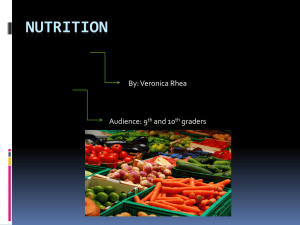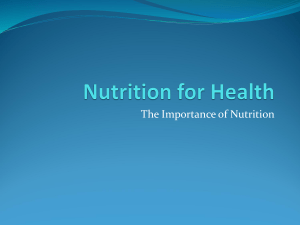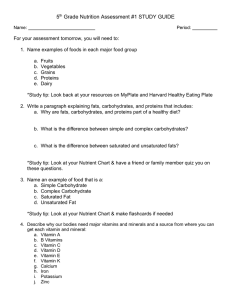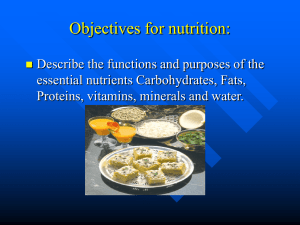02. Hygienic requirements on organization of rational and treatment
advertisement
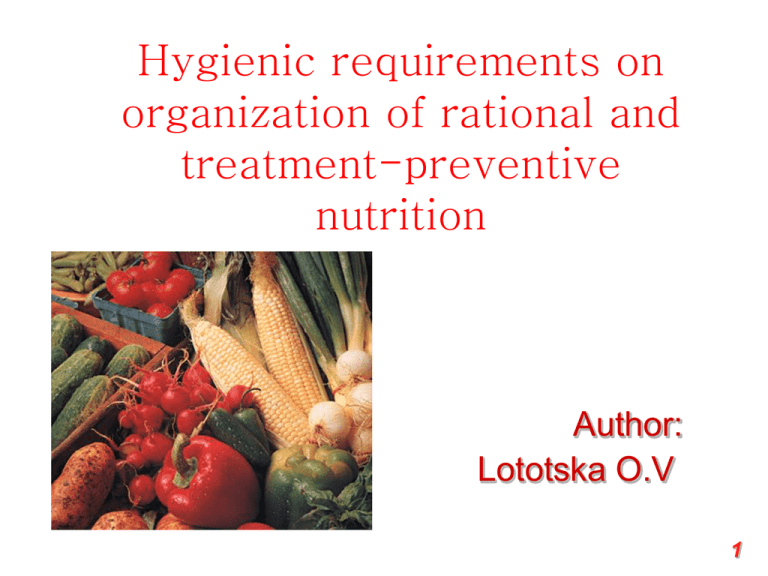
Hygienic requirements on organization of rational and treatment-preventive nutrition Аuthor: Lototska O.V 1 Nutrition may be defined as the science of food and its relationship to health. It is concerned primarily with the part played by nutrients in body growth, development and maintenance. Function of nutrition Provision of energy Body building and repair Maintenance and regulation of tissue functions In various historical times structure of nutrition and character of a nutrition changed depending on development of industrial forces of a society, climate-geographical conditions, direction of economic activity and so on. The character of nutrition of the population was formed gradually depending on an economic and cultural level of development of the country, in view of national customs and features. Through centuries, food has been recognized as important for human beings in health and disease. Good nutrition is a basic component of health. The relation of nutrition to health may be seen from the following view points: Growth and development: Good nutrition is essential for the attainment of normal growth and development. Not only physical growth and development, but also the intellectual development, learning and behaviour are affected by malnutrition. Specific deficiency: Malnutrition is directly responsible for certain specific nutritional deficiency diseases. Good nutrition therefore is essential for the prevention of specific nutritional deficiency diseases and promotion of health. Resistance to infection: Infection, in turn, may aggravate malnutrition by affecting the food intake, absorption and metabolism. Mortality and morbidity: The indirect effects of malnutrition on the community are even more striking - a high general death rate, high infant mortality rate, high sickness rate and a lower Expectation of life. 'You are what you eat', some people say. If you eat rubbishy food, you can't really expect to grow up strong and healthy. But if you eat goodquality food, you've a good chance of doing so. Generally, a healthy diet is said to include: •Sufficient calories to maintain a person's metabolic and activity needs. For most people the recommended daily allowance of energy is 2,000 calories, but it depends on age, sex, height, weight, and physical activity. •Sufficient quantities of fat, including monounsaturated fat, polyunsaturated fat and saturated fat, with a balance of omega-6 and long-chain omega-3 lipids. The recommended daily allowance of fat is 65-80 grams. •Maintenance of a good ratio between carbohydrates and lipids (4:1): four grams of the first for one gram of the second. •Avoidance of excessive saturated fat •Avoidance of trans fat. •Essential micronutrients such as vitamins and certain minerals. •Sufficient essential amino acids ("complete protein") to provide cellular replenishment and transport proteins. All essential amino acids are present in animals. A select few plants (such as soy and hemp) give all the essential acids. A combination of other plants may also provide all essential amino acids (except rice and beans which have limitations). •Avoiding directly poisonous (e.g. heavy metals) and carcinogenic (e.g. benzene) substances; •Avoiding foods contaminated by human pathogens (e.g. E. coli, tapeworm eggs); •Avoiding chronic high doses of certain foods that are benign or beneficial in small or occasional doses, such as foods that may burden or exhaust normal functions (e.g. refined carbohydrates without adequate dietary fiber); foods that may interfere at high doses with other body processes (e.g. refined table salt); foods or substances with directly toxic properties at high chronic doses (e.g. ethyl alcohol). •Combination of foods eaten and timing of meals so that hunger is kept in check. CLASSIFICATION OF FOODS 1.Classification by predominant functions: Energy-giving foods. These constitute fats and carbohydrates. They are also called protein sparer. Proteins also produce energy to some extent. Cereals, roots and tubers, dried fruits, sugars and fats belong to this group. They supply heat and energy to the body. Body building foods. These are foods rich in proteins, mineral salts and water. Milk, meat, fish, pulses, oilseeds and nuts fall in this category. Protective foods. These constitute inorganic salts, vitamins and minerals. They include proteins and water. Milk, eggs, liver, green leafy vegetables and fruits are included in this group. They build our bones, teeth, muscles, soft tissues, blood and other body fluids. They provide material for repair in the body as wear and tear goes on constant. 2. Classification by origin: • Foods of animal origin • Foods of vegetable origin 3. Classification by chemical composition: • Proteins 4. Classification by nutritive value: • Fats •Cereals and millets • Carbohydrates •Pulses (legumes) • Vitamins •Vegetables • Minerals •Nuts and oilseeds •Fruits •Animal foods •Fats and oils •Sugar and jaggery •Condiments and spices •Miscellaneous foods Balanced diet is one, which will meet a person's caloric need and contain all nutrients, particularly proteins, and vitamins. In addition, the food should satisfy the taste and desire of a person and should have enough roughage to promote the peristalsis. Balanced diet should have 50-60 % carbohydrates 30-35 % fats and 10-15 % proteins with necessary vitamins and minerals. A balanced diet must contain foods from the above three groups. Importance of the main components of food in nutrition of the human Nutrients are organic and inorganic complexes contained in food. There are about 50 different nutrients which are normally supplied through the foods we eat. Each nutrient has specific functions in the body. Most natural foods contain more than one nutrient. These may be divided into : (i) Macronutrients: These are proteins, fats and carbohydrates which are often called "proximate principles" because they form the main bulk of food. (ii) Micronutrients : These are vitamins and minerals. They are called micronutrients because they are required in small amounts which may vary from a fraction of a milligram to several grams. PROTEINS The word "protein" means that which is of first importance. Indeed they are of the greatest importance in human nutrition. Proteins are composed of carbon, hydrogen, oxygen, nitrogen and sulphur in varying amounts. Some proteins also contain phosphorus and iron and occasionally other elements. Proteins differ from carbohydrate and fat in the respect that they contain nitrogen. Proteins are made up of simpler substances, called amino acids. These are the building blocks of protein Some 22 amino acids are stated to be needed by the human body, out of which eight are called "essential". Proteins are needed by the body: For growth and development: They furnish the building material, the amino acids from which the body proteins are synthesized. For repair of body tissues and their maintenance: It has been shown that the body proteins are constantly being broken down; they have to be replaced for which fresh protein intake is required. For synthesis of antibodies, enzymes and hormones: Antibodies, enzymes and hormones contain protein. The body requires protein to produce them. Proteins can also furnish energy to the body, but generally the body depends for its energy on carbohydrates and fats rather than proteins. Sources of protein Animal sources: Plant sources: Protein requirements Doctors recommended 1,0 g. protein/kg body weight for an adult. Daily allowances recommended by experts of the World Health Organization (Geneva, 1976) is 37 g of protein per day for the standard man with mass of body 65 kg for professions of average hardness (II group) and 29 g of protein for the standard woman with body mass 55 kg. Effects of protein deficiency: Adults: Loss of weight, underweight, poor musculature, anemia, increased susceptibility to infection, frequent loose stools, general lethargy, incapacity to sustained work, delay in wound healing, cirrhosis of liver, oedema, ascitis, etc. CARBOHYDRATES Chemically carbohydrates are composed of carbon, hydrogen and oxygen as the name implies. Polysaccharides are various starches which are converted into two molecules saccharides i.e. cane sugar, beet sugar, milk sugar and malt sugar. These on further, glucose and digestion change into single molecule monosaccharides fructose. Foods that are high in carbohydrates: Breads, pastas, beans, potatoes, bran, rice and cereals. The original source of all starches and sugars is green plants. When plants have excessive sugar and they need to store it, as reserve supply of food, plant body is capable of changing its sugar into starch. Carbohydrates are abundantly present in food. All carbohydrates have to be changed into glucose and fructose before they can be absorbed into the body. 1 gm of carbohydrates yields 4.1 calories of heat. The daily requirement of carbohydrates varies from 50 to 60% of total energy intake. The carbohydrates are chief sources of energy. In the active muscles, the glucose is oxidized for the production of energy and warmth. Glucose which cannot be used immediately, is converted into glycogen and stored in the liver and muscles or converted into fat and stored under the skin. There are three main sources of carbohydrate: Starches: These are present in cereals (rice, wheat); roots and tubers (potatoes). Sugars: (a) Monosaccharides: glucose, fructose, galactose. (b) Disaccharides: Sucrose, lactose, maltose. (c) Cellulose: This is the tough fibrous lining found in vegetables, fruits, cereal, etc. It is hard to digest and has no nutritive value. However, cellulose acts as "roughage" and prevents constipation. Fats are composed chemically of carbon, hydrogen and oxygen, only in different proportion than they are contained in carbohydrates. There is less of oxygen in fats than in carbohydrates. Fats are a form of concentrated food and like carbohydrates, they are used as body fuels for the production of heat and energy. As fats are not soluble in water, the process of digestion changes the fat into an emulsion form for their absorption into the body. Liquid fats and those which melt at body temperature are somewhat better digested than those which are much harder. Fats serve the following functions: • Dietary fat is a concentrated source of energy. One gram of fat supplies 9 calories of energy. • Fats are carriers of fat-soluble vitamins, e.g., vitamins A, D, E and K. • Dietary fat supplies "essential fatty acids". Linoleic acid, one of the essential fatty acids, prevents scaly skin formation. • The fat layer below the skin plays an important role in maintaining our body temperature. • Fats provide support for many organs in the body such as heart, kidney, intestine etc. • Foods containing fats are tasty. Animal sources: These are ghee, butter, fat of meat, fish oils, etc. Vegetable sources: These are various vegetable oils such as groundnut, gingely, mustard, cottonseed, safflower (kardi) and coconut oil. VITAMINS These are complex organic substances contained in food and are very essential for the normal growth and nutrition of animals. In fact, they are vital accessory food factors required for the maintenance of optimum, health. They are present in various foods in minute quantities and diet devoid of vitamins, if taken for some period, gives rise to certain diseases known as deficiency diseases and may ultimately even cause death. They do not supply energy but are simply protective foods. vitamins Fat -soluble Vitamins Water-soluble Vitamins Thiamine (B1) Riboflavin (B2) A (retinol) E (tocopherol) Niacin (B3) D (calciferol) Pyridoxine (B6) Pantothenic acid Cobalamin (B12) Ascorbic acid Folic acid K (menadione) Diseases, that is direct or mediate related with a nutrition 1. Alimentary disease, illness caused by deficiency or surplus of components of nutrition. The secondary illnesses of insufficiency or excessive nutrition, which is developed as complication on a background of wearisome illnesses (surgical, infectious, oncology and others.) 2. 3. Disease of multifactor nature that very much frequently develops on a background of genetic predilection, for example, atherosclerosis, gout, idiopathic hypertension, etc. 4. Disease, which are transferred by a nutritional way (some infections diseases and intestinal worms, alimentary poisonings). 5. Alimentary intolerance atypical reaction to nutrition, for example alimentary allergy, idiosyncrasy. Illnesses caused by improper nutrient consumption NUTRIENTS DEFICIENCY EXCESS Calories Starvation Obesity, diabetes mellitus, Cardiovascular disease Simple carbohydrates Marasmus, starvation diabetes mellitus Complex carbohydrates Marasmus, starvation Obesity Saturated fat / trans fat none Cardiovascular disease, Unsaturated fat Rabbit starvation Obesity Cholesterol none Cardiovascular disease Protein Marasmus Sodium hyponatremia Iron Anemia Ketoacidosis, Rabbit starvation, kidney disease Hypernatremia, hypertension Hepatitis C, cirrhosis, heart disease Iodine Goiter, hypothyroidism Iodine Toxicity (goiter, hypothyroidism) Vitamin A Xerophthalmia and Night Blindness Vitamin B1 Beri-Beri Vitamin B2 Cracking of skin and Corneal Unclearation Niacin Pellagra Vitamin B12 Pernicious Anemia Vitamin C Scurvy diarrhea causing dehydration Vitamin D Rickets Hypervitaminosis D (dehydration, vomiting, constipation) Vitamin E Hypervitaminosis A (cirrhosis, hair loss, birth defects) dyspepsia, cardiac arrhythmias, birth defects Hypervitaminosis E (anticoagulant: excessive bleeding) Nutritional Diseases: 1. Protein Calorie Malnutrition (PCM). (i) Kwashiorkor. It results from consumption of very low protein in diets of low biological values, yet providing just enough energy to satisfy the needs of the child. This condition is usually seen in children between the age group of 1-4 years. This symptom is characterized by pitting oedema, anemia, retarded growth, loss of appetite, diarrhoea, scanty hair growth... • (ii) Marasmus. It is a clinical condition of protein energy malnutrition, primarily due to total deprivation of the requisite calories required by the body. It usually occurs in the age group of 1/2 to 5 years. This syndrome is characterized by failure to gain weight, wasting of muscles and of subcutaneous fat. The child feels good appetite but is irritable. • (iii) Marasmic-Kwashiorkor. Patients suffering from Marasmic-Kwashiorkor show clinical symptoms of both Marasmus and Kwashiorkor. 3. Mineral Deficiencies (i) Deficiency of iodine in water and feed leads to goitre or cretinism. 3. Mineral Deficiencies (ii) Lack of flourine ( < 0.5 ppm) in water leads to caries. (iii) Calcium deficient diets lead to rickets and osteomalacia. 3. Mineral Deficiencies (iv) Iron deficiency diets lead to anaemia, (v) There are other important minerals like copper, selenium etc. Usually their requirements are so little that deficiency conditions do not occur. 4. Vitamins Deficiencies (i)Lack of vitamin A results in xerophthalmia, Bitot's spots, night blindness and keratomalacia. 4. Vitamins Deficiencies (ii) B Complex: Deficiency of Thiamine leads to beriberi. Niacin deficiency results in pellagra. Riboflavin deficiency symptoms are angular stomatitis, cheilosis, scrotal dermatitis and corneal vascularisation. (iii) Vitamin C deficiency leads to scurvy, spongy bleeding gums, haemorrhages in skin and other haemorrhages, (iv) Vitamin osteomalacia. D deficiency result in rickets and (v) Vitamin K deficiency leads to hypoprothrombinaemia, which further leads to haemorrhages. 5. Problems of Overnutrition (eating too much) Proteins/fats/carbohydrates • Cardiovascular disease • Some cancers • Diabetes mellitus • Insulin resistance • • Obesity The main features of obesity are overweight and fatness. It is mostly caused by overeating and intake of abundance of calories Metabolic syndrome Vitamin poisoning • (i) Hypervitaminosis A is at times caused by excess of vitamin A therapy. The manifestation are headache, nausea, vomiting, irritability and anorexia. Carotenaemia is also caused due to excessive consumption of carrots which is characterised by yellow skin with normal conjunctiva Vitamin poisoning (ii) The toxic manifestations of hypervitaminosis D are anorexia, nausea, vomiting, thirst, polyuria and drowsiness. Calcium and phosphorus levels in serum and urine are raised. Calcium may be deposited in many tissues also (iii) Fluorosis occurs if fluorine is available > 1,5 mg in 1 liter water. It is characterised by (a) dental fluorosis, i.e., mottled enamel of teeth and (b) skeletal fluorosis i.e., dense bone formation, severe spondylitis and even calcifications of ligaments of spine and tendinous inflamation of other muscles in severe cases. Food allergies Some people have allergies or sensitivities to foods which are not problematic to most people. This occurs when a person's immune system mistakes a certain food protein for a harmful foreign agent and attacks it. About 2% of adults and 8% of children have a food allergy. Commonly food allergens are gluten, corn, shellfish (mollusks), peanuts, and soy. Most patients present with diarrhea after ingesting certain foodstuffs, skin symptoms (rashes), bloating, vomiting and regurgitation. The digestive complaints usually develop within half an hour of ingesting the allergen. Rarely, the food allergy chelce can lead to anaphylactic shock: hypotension (low blood pressure) and loss of consciousness. This is a medical emergency. An allergen associated with this type of reaction is peanut, although latex products can induce similar reactions. Diet and Disease Nutrition and Cancer Protection These days there is great interest in the effect of diet on cancer risk. Much research is under way to evaluate and clarify the role that diet and nutrition play in the development of cancer. Although no direct cause-and-effect relationship has been proved, statistics do show that some foods may increase or decrease the risk for certain types of cancer. -Keep a Normal Body Weight. Obesity is linked to increased death rates from some cancers in humans, particularly those of the prostate, pancreas, breast, ovary, colon, gallbladder, and uterus. -Avoid Too Much Fat in Your Diet, Both Saturated and Unsaturated. Evidence from epidemiologic studies suggests a relationship between dietary fat levels and the occurrence of prostate, colorectal, and other cancers. Currently, the reasons for such correlations are unclear. -Eat Foods Rich in Fiber. The National Cancer Institute recommends a fiber intake of 25 to 35 grams each day. Dietary fiber appears to protect the body against some forms of cancer, particularly colorectal. The manner in which specific types of fiber work is unclear. Therefore, eat fiber daily from various dietary sources such as fresh fruits, vegetables, and whole-grain products. -Eat Foods Rich in Vitamins A and C Daily. Examples of these foods include dark green and deep yellow fresh vegetables and fruits, such as carrots, spinach, sweet potatoes, cantaloupe, and apricots, as sources of vitamin A. Oranges, grapefruit, strawberries, and green and red peppers supply vitamin C. Vitamin A may help decrease the incidence of several cancers, including those of the oral cavity, pharynx, larynx, and lung. -Include Vegetables as Part of Your Regular Diet. Broccoli, cabbage, Brusselssprouts, kale, cauliflower, kohlrabi, mustard greens, and Swiss chard are a few recommended examples. Research shows that these foods seem to offer protection from the development of colorectal, stomach, and lung cancers. -Eat• Only Moderate Amounts of Salt-Cured, Smoked, and Nitrite-Cured Foods. This group of foods includes smoked and cured meats such as bacon, sausage, ham, and others. The incidence of cancers of the esophagus and of the stomach is higher among populations in which large quantities of these foods are eaten. Some cooking methods, such as barbecuing or smoking, can produce substances that might cause cancer thus, be moderate in using these methods. -If You Drink Alcohol, Do So in Moderation. Drinking large quantities of alcohol over a long period of time increases your risk of liver cancer. Combining alcohol consumption with smoking or chewing tobacco increases your risk of cancer of the mouth, larynx, throat, and esophagus. A limit of two or fewer drinks per day is recommended. Salt and Hypertension Too much salt (sodium chloride) in the human’s diet has been the focus of much study and has been given much attention by the media in recent years. • • • • • • If you need to limit your salt intake, begin with the food you prepare. Do not use salt when you cook, or use it only in very small amounts. Avoid salty foods such as chips and pickled foods. Switch from salted butter and margarine to unsalted. Be aware that many processed foods contain large amounts of salt. Get in the habit of scrutinizing food labels. Condiments such as ketchup, prepared mustard, and soy sauce are all high in sodium. Prepared foods such as canned soups, stews, and broths and cured foods such as ham, bacon, cold cuts, and hot dogs also are high in salt content. As a part of the treatment of hypertension, restriction of sodium to less than 2 or 2.5 grams daily is commonly recommended. This restriction can usually be achieved without great inconvenience. Greater degrees of restriction are used for treatment of persons who have certain forms of kidney disease. Diabetes Diet Other recent changes in diabetic management include: -Reasonable Weight Goals. Being overweight can make it more difficult to control blood sugar. -Flexible Fat Levels. If you're at a healthful weight and have a normal blood cholesterol level, new guidelines encourage you to keep fat to no more than 30 percent of total calories. -Calculated Use of Sugar. Sugar is no longer forbidden. People with diabetes have long been told that simple carbohydrates — sweets such as table sugar, honey, jelly, fruit juice, and candy—cause a rapid rise in blood sugar. Complex carbohydrates—starches such as breads, cereals, and potatoes — were believed to cause a moderate increase in blood sugar. But new information shows that table sugar affects blood sugar about the same as bread, rice, and potatoes. It's the total amount of carbohydrate in the diet, rather than the source, that is the critical factor affecting blood sugar levels after meals. Using modest amounts of sugar may not interfere with blood sugar control—as long as you substitute a sugary food for a starchy food that contains an equal amount of carbohydrate. Meal planning for people with diabetes continues to be a nutritionally balanced, flexible style of eating. Avoiding Heart Disease Some factors that put you at high risk for heart disease are beyond your control (for example, your heredity). But one risk factor, a high blood cholesterol concentration, may be affected by what you eat. In short, reduce the amount of fat and cholesterol you consume, particularly if you are susceptible to having a high cholesterol value. For most people, this need not involve a revolution in eating patterns. Moderation is the key. Small changes, consistently followed, can have a significant impact. Control questions: • What are the main function of nutrition? • What are main principles of nutrition for cancer protection? Thank you for your attention!

